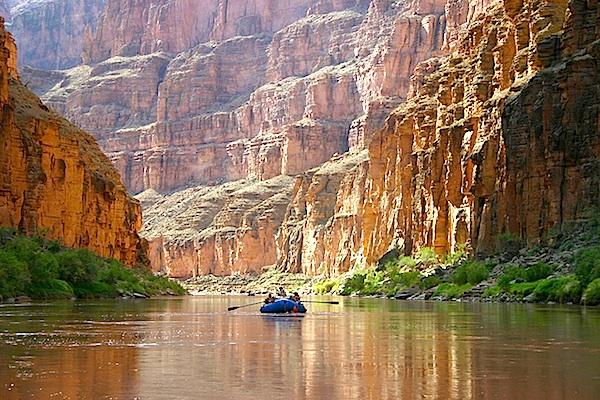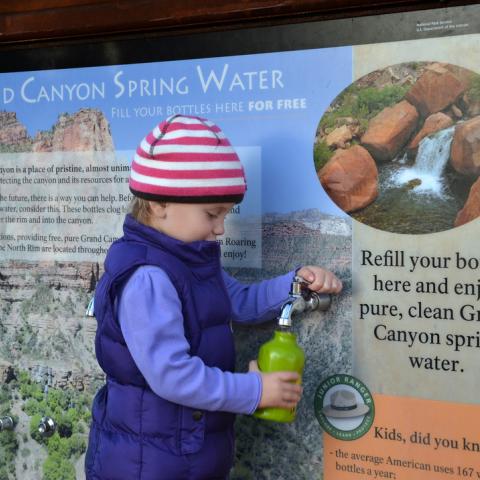There are more than a few experiences of a lifetime to be had in the National Park System. But arguably two right at the top of anyone's list would be a raft trip on the Colorado River through Grand Canyon National Park, and a multi-month sojourn along the Appalachian National Scenic Trail.
Which would you choose?

Which would you prefer, a multi-month A.T. hike, or....

...a multi-week float trip through the Grand Canyon?/NPS photos
Both require investments of time and no small measure of commitment.
A Colorado River trip through that great rift that is Grand Canyon National Park can take anywhere from 16 to 21 days if you take your time. Of course, an end-to-end hike on the spine of the Appalachian Mountains that the A.T. follows can take four-and-a-half to five months or more. Both treks drop you into wilderness settings -- moreso in the Grand Canyon than on the A.T., granted -- and both are sure to tell you a little bit about yourself.
Both journeys would reveal spectacular scenery, whether it's the Inner Gorge of the Grand Canyon with its waterfalls or the rumpled back of Great Smoky Mountains National Park.
So, let's hear it travelers. Which journey is more appealing to you, and which is more likely to get checked off your to-do list?




 Support Essential Coverage of Essential Places
Support Essential Coverage of Essential Places







Comments
Two very different experiences. I have done the AT and had an opportunity to do the Canyon a few years ago but passed. I guess if one votes with your feet, that puts the AT on top for me.
A few of observations on the comments above:
1) While the AT often takes you close or through civilization, there are major sections of pure wilderness. On a gross miles basis, far more than the Grand Canyon.The AT also offers alot more variety - though not the thrills of running rapids.
2) You'd be trucking to do the AT in 4 1/2 months. According to the AT Convervancy the hike typically takes 5 to 7 months and that is only if you are part of the 25% that makes it all the way. Fortunately, the percent making it the whole way of those intending to try in the GC is much higher ;)
3) The 16-21 day version of the Grand Canyon assumes the use of an unpowered raft and includes long stretches of very slow movement. An alternative is a commericial trip using powered rafts that can speed through those slow sections and cut the time in half.
Not even close for me. I'll take the Grand Canyon (I have only hiked part of the AT). In addition to the different rafting experiences (thrill of whitewater or solitude on flat calm water), you can also take some spectacular side hikes. The scenery of the Grand Canyon is also more unique than that of the AT (in my opinion). I think it is also easier to get similar experience to the AT in many parts of the U.S. vs. the Grand Canyon. EC is right though, two vastly different and enjoyable experiences.
I agree, these are two very different experiences. I did a ratfing trip through the Grand Canyon. You get a real appreciation for the magnitude ofthe Grand Canyon from river level, and the opportunitues for exploring and seeing hard to reach places can't be beat. You pack a lot of experiences in a 1 or 2 week period.
I have hiked sections of the AT in Georgia and North Carolina. While the AT is unique for its length, most people don't have the time to commit to a thru hike. I am just as happy hiking in national parks.
I agree, these are two very different experiences. I did a ratfing trip through the Grand Canyon. You get a real appreciation for the magnitude ofthe Grand Canyon from river level, and the opportunitues for exploring and seeing hard to reach places can't be beat. You pack a lot of experiences in a 1 or 2 week period.
I have hiked sections of the AT in Georgia and North Carolina. While the AT is unique for its length, most people don't have the time to commit to a thru hike. I am just as happy hiking in national parks.
I have hiked short sections of the AT and do not care for the second growth jungle of small trees. I am happiest in treeless country unless it is the high sierra with it's huge trees, open understory, and slick rock granite. I have not done a boat trip in the Grand Canyon but have walked from top to bottom on both sides of the river and much prefer it over the AT.
Roger, I can assure you the AT has more than its fair share of large tees and treeless areas with massive vistas. That is one of the great things about the AT - huge variety.
If I had to choose I would go with the rafting trip through the Grand Canyon. I can't imagine backpacking for months on the AT. I'm sure it would be great, but I like the idea of the shorter trip on the river with the excitement of running the famous rapids.
The wonderland trail - all of it!